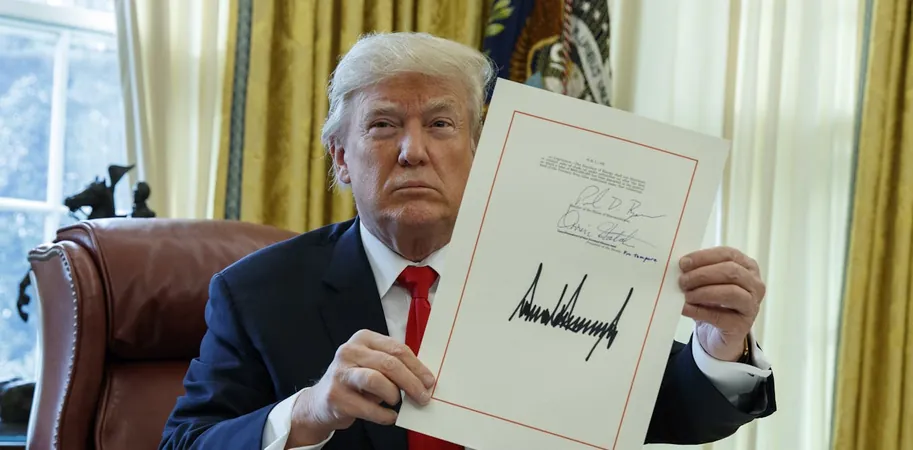
Trump's Economic Agenda: Tax Cuts, Deregulation, and the Looming Debt Crisis
2024-11-08
Author: Ken Lee
Tax Cuts That Could Transform the Economic Landscape
Central to Trump's economic policy are the tax reforms initiated by the Tax Cuts and Jobs Act of 2017. Nearly all provisions of this law are set to expire by the end of 2025, leading to predictions of a staggering $4 trillion tax hike if they aren't extended. Families struggling with the aftereffects of high inflation could face even heavier financial burdens, which contributed to Trump's electoral success.
Critics and supporters alike argue that extending the individual income tax cuts will not only prevent a steep rise in marginal tax rates but also stimulate economic output in the long run. By allowing for lower taxes, consumer demand for goods and services is expected to rise, creating more job opportunities, driving savings and investments, and ultimately leading to a more dynamic economy. The act also simplified tax codes by doubling the standard deduction and increased the child tax credit, helping to alleviate the tax burdens on middle and lower-income families.
Given Trump's track record with these provisions, extending the tax cuts is a likely outcome—especially with a Republican majority, which may put additional pressure on Congress to act.
Deregulation: A Boon for Businesses?
Beyond tax cuts, Trump’s agenda includes an aggressive push to eliminate red tape that could stifle business innovation and investment. Several key provisions hanging in the balance include the 20% deduction for small businesses and incentives for expensing equipment costs—both essential for fostering growth in the small business sector.
The 20% small-business deduction has been credited with creating approximately 1.2 million jobs annually. Meanwhile, allowing immediate expensing of equipment may boost long-term economic output by as much as 5%. Such policies are vital in ensuring small businesses remain competitive against their larger counterparts.
Moreover, Trump’s previous regulatory reforms during his first term significantly reduced the economic burden traditionally imposed by regulations, suggesting that his second term could further unleash entrepreneurial spirit across the nation. With the advent of cutting-edge technologies, particularly in artificial intelligence, ensuring that regulatory frameworks are conducive to innovation will be critical for sustaining economic growth in a digital age.
The Elephant in the Room: National Debt
While the prospects for economic growth appear promising, a looming concern remains: the national debt. Since 2000, U.S. debt has soared from $10 trillion to over $35 trillion, with projections by the Congressional Budget Office warning of a debt-to-GDP ratio that could reach an alarming 166% by 2054.
Extending tax cuts without taking measures to rein in spending could exacerbate this dilemma, leading to even higher deficits. It’s not just about avoiding tax hikes; it’s essential to address spending levels effectively. That may involve finding offsets, such as budget cuts, to prevent the fiscal situation from spiraling further out of control.
A potential solution may lie in convening a bipartisan fiscal commission to explore sustainable fiscal policies. Such a body could devise strategies that do not compromise economic growth while addressing the deficit.
Conclusion: A Fork in the Road for the U.S. Economy?
As Trump prepares for a potential return to the White House, the decisions made regarding tax policies and regulatory frameworks will undoubtedly shape the future of the U.S. economy. The path he chooses could lead to significant economic revitalization—or plunge the nation into deeper fiscal challenges. The question remains: will the benefits of tax cuts and deregulation outweigh the looming cost of a ballooning national debt? Stay tuned, as the unfolding political landscape may hold the answer.



 Brasil (PT)
Brasil (PT)
 Canada (EN)
Canada (EN)
 Chile (ES)
Chile (ES)
 España (ES)
España (ES)
 France (FR)
France (FR)
 Hong Kong (EN)
Hong Kong (EN)
 Italia (IT)
Italia (IT)
 日本 (JA)
日本 (JA)
 Magyarország (HU)
Magyarország (HU)
 Norge (NO)
Norge (NO)
 Polska (PL)
Polska (PL)
 Schweiz (DE)
Schweiz (DE)
 Singapore (EN)
Singapore (EN)
 Sverige (SV)
Sverige (SV)
 Suomi (FI)
Suomi (FI)
 Türkiye (TR)
Türkiye (TR)